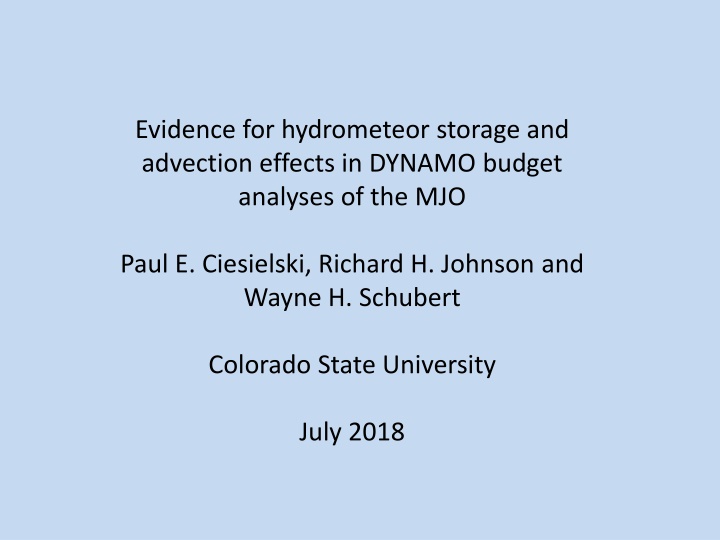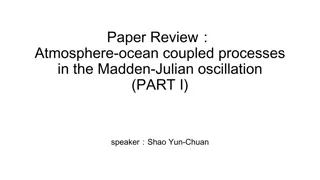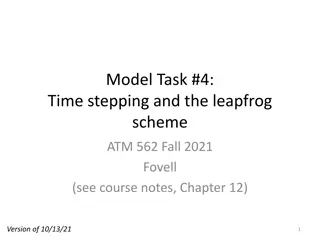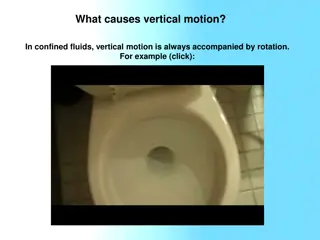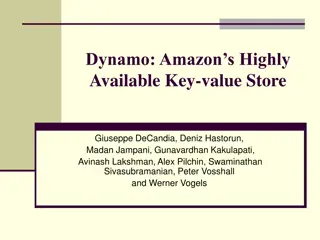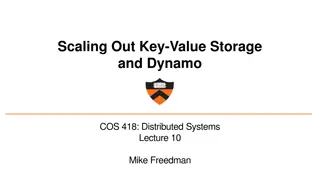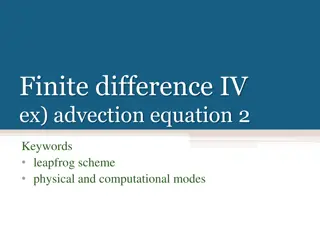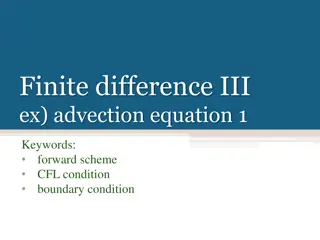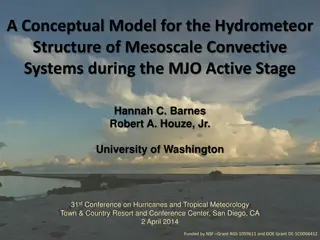Evidence for Hydrometeor Storage and Advection Effects in DYNAMO Budget Analyses of the MJO
Variational constraint analyses (VCA) were conducted for DYNAMO in two regions to compare observed radar rainfall data with conventional budget method results, examining differences and composite analyses of MJO events. The study utilized input data including Gridded Product Level 4 sounding data and legacy radar rainfall datasets. Insights were drawn regarding hydrometeor storage and advection effects on MJO behaviors.
Download Presentation

Please find below an Image/Link to download the presentation.
The content on the website is provided AS IS for your information and personal use only. It may not be sold, licensed, or shared on other websites without obtaining consent from the author.If you encounter any issues during the download, it is possible that the publisher has removed the file from their server.
You are allowed to download the files provided on this website for personal or commercial use, subject to the condition that they are used lawfully. All files are the property of their respective owners.
The content on the website is provided AS IS for your information and personal use only. It may not be sold, licensed, or shared on other websites without obtaining consent from the author.
E N D
Presentation Transcript
Evidence for hydrometeor storage and advection effects in DYNAMO budget analyses of the MJO Paul E. Ciesielski, Richard H. Johnson and Wayne H. Schubert Colorado State University July 2018
Variational constraint analyses (VCA) were produced for DYNAMO for two regions one covering the radar domain of Gan (VCA-Gan) and a second one roughly covering the NSA (VCA-NSA). The VCA-Gan product was constrained using SPOL radar rainfall. The VCA-NSA product was constrained using TRMM data since radar rainfall data were not available over this larger domain. This study will consider differences between the observed SPOL radar rainfall to that computed by the conventional budget method (CM) averaged over the the VCA-Gan domain. The CM method used here employed finite differences of the budget equations using an objectively analyzed gridded product. NSA SSA
Input for Gridded Product Level 4 sounding data (uniform 5-hPa resolution) augmented with: - CIMSS cloud-drift satellite winds, ASCAT surface winds, and COSMIC thermodynamic profiles (Td not used below 850 hPa) Enhancements to sounding data set: 1. To better resolve the diurnal cycle, the 4/day soundings at Mal and Colombo were interpolated to a 3-h time resolution. 2. An adjustment procedure was developed, making use of low-level ECMWF OA, to mitigate the Sri-Lanka island effects on Colombo soundings Details for Objectively Analyzed Gridded Product (1 October to 31 December 2011) Multiquadric interpolation to produce gridded analyses of basic fields - 3-hr, 1 horizontal res. (35-155 E, 20 S-20 N), 25-hPa vertical res. (sfc to 50 hPa) - ECMWF Operational Analyses (OA) used in data sparse regions outside of core sounding network.
(Top) Time series of SPOL radar rainfall based on the DYNAMO legacy radar rainfall dataset. Radar, which measure rainfall within 150km radius of Gan, captured 3 MJO events in October to December period. (Bottom) Time series of budget- derived rainfall averaged over the VCA-Gan domain. Red line shows low-pass filtered rainfall time series with thin vertical lines denoting time of peak rainfall for each MJO event. This time was used to define an index to composite the three MJO events together.
3-MJO Composite Analyses Comparison of diagnosed fields from CM (left) and CVA (middle) based on 3-MJO composite. Right panels show composite cloud parameters (area-top, optical depth middle). High clouds show rapid increase in area coverage and optical depth during MJO build-up stage. High cloud area begins to decrease after day +3. High cloud shadow lower cloud fields rendering them less reliable. Lower-right panel show budget- derived (CM) and SPOL composite rainfall. Magnitude of derived fields is larger in CM in the MJO build-up stage (prior to day 0) consistent with rainfall differences. Slightly more pronounced vertical tilt to vertical motion and Q1 fields in build-up stage in CVA.
Time series of cloud liquid water tendency over the Gan VCA domain from ECMWF analysis. This was used in the VCA to include the effects of cloud water storage. Composite tendency of cloud liquid water shows positive tendency in MJO buildup stage and negative tendency in decay stage consistent with changes seen in CERES cloud fields. Cloud water tendencies are 2 orders of magnitude less than differences in budget-derived and observed SPOL composite rainfall (seen below). days MJO stage CM rain (mm/day) SPOL rain (mm/day) CM-SPOL (mm/day) -12 to -1 build-up 11.9 10.3 +1.6 CM SPOL 4 to 12 decay 6.6 7.4 -0.8 CM overestimates rainfall by ~15% during build-up stage of MJO and underestimates rainfall by ~11% during decay stage of MJO
Cloud liquid water tendency from ECMWF analysis used in VCA method. Cloud liquid water tendency deduced from 2- channel MWR observations on Gan. Poor correspondence in time series of two analyses but composite plots are consistent in showing positive tendencies in MJO build-up stage and negative tendencies in decay stage. Both composites suggest that cloud storage tendencies account for only a small percentage (maybe 5%) of rainfall difference noted above (~0.05 mm/day out ~1 mm/day).
? ?? ??+ ?? ?? ??+ ?? ?? ? ?? ?? ????? ?? ?? = ?0+ 0 ?0 ??+ ? ?? ? ??+ ??+ ?? ?? + ?? ??+ ??+ ?? + ?? ??+ ??+ ?? ? ??+ ??+ ?? ?? Improved Moist Physics (IMP) ?? ??? = ?0+ 0 ?0 + ? ????? ?? ?? ? ???: ?? , is water vapor mixing ratio ?? , is the airbone condensed water mixing ratio ?? , is the precipitating water mixing ratio ?? = ??+ ??+ ?? The conventional budget method (CM) computes precipitation using the only storage and advection of the water vapor ( ??). Such a method is well suited for used with radiosonde observations which provide all needed fields. Computing precipitation using improved moist physics considers storage and advection of ?? (i.e., water vapor and hydrometeors). The VCA method considers the effects of ? ?? ??(cloud water storage) which we have noted account for only about 5% of the rainfall difference ????? between observed and budget- derived estimates (?0 hydrometeor advective effects likely account the majority of ?????. To estimate these effects will require a model as these quantities are not available from observations. ??) seen in the composite MJO. Therefore precipitation storage and
Some conclusions and recommendations: Diagnosed fields computed from the conventional budget method are susceptible to a variety of errors (e.g., insufficient sampling, instrument and measurement errors). Here we considered errors due to using an approximate form of moist thermodynamics (specifically, errors due to hydrometeor storage and advection effects). These effects may appear in conventional budgets as a poor match between observed and derived rainfall. For a 3-MJO composite during the DYNAMO period, these effects resulted in rainfall errors on the order of 10%. Cloud water storage accounted for only about 5% of this rainfall difference. Therefore precipitation storage and hydrometeor advective effects likely account the majority of rainfall difference. - Models should allow us to estimate the magnitude of these effects since observations of these effects are not available. - Small networks are likely more prone to hydrometer advection/storage effects
CSU analyses over VCA-Gan domain budget rainfall Pb TRMM VCA-Gan constrained by TRMM rainfall TRMM rainfall VCA-Gan constrained by adjusted SMART-R rainfall SMART-R adjusted TRMM rainfall CSU budget analysis does reasonable of job capturing MJO signal near Gan despite lack of budget array there. Using SMART-R adjusted rainfall increases amplitude in low-level Q1andQ2 in build-up stage and decreases their amplitude during active and decaying phases (day -5 to +10) Using ground-based SMART-R radar estimates appears to have produced improved vertical structure of heating and moistening fields during course of MJO
DYNAMO NSA 3-MJO composite CSU NSA analysis TRMM Pb VCA-NSA constrained by TRMM rainfall Slightly more prominent vertical tilt in Q1 and Q2 in CSU analysis (thin black line shows max heating and moistening line) Amplitudes of Q1 and Q2 fields are larger in VCA consistent with TRMM rainfall being larger than budget rainfall Pb. Pb underestimates TRMM rainfall at low rates and over estimates at high rates similar to SMART-R comparison with TRMM at Gan Negative rain rates at times in budget rainfall due to sampling errors
Evidence for cloud water storage effects ??? VCA-NSA domain VCA-Gan domain Plots show composite evolution of cloud fields during passage of 3 MJOs during DYNAMO. In general, cloud fields increase approaching day 0 (rainfall peak), then decreases. High clouds (cirrus) peak a few days following rainfall peak. Lower cloud features are shielded by upper-level clouds rendering their evolution unreliable. Over Gan region, Pb > P as cloud field increases, Pb < P as cloud field decreases consistent with cloud storage effects. This signal was not clear over VCA-NSA. (Note, P here is from TRMM 3B42 product not ground based radar). P Pb P Pb
